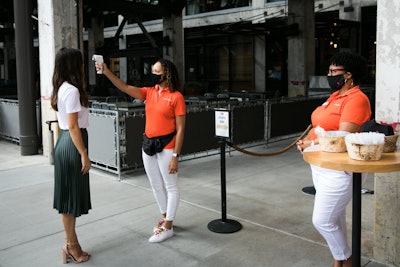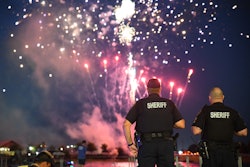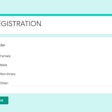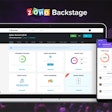
Registration and check-in can be one of the biggest danger areas of a live or hybrid event during COVID-19—but it’s also one of the best places to lay the groundwork for a safe gathering. Consider these smart strategies to keep attendees safe as soon as they arrive.
1. Do as much as possible in advance.
Consider eliminating on-site check-in lines by coordinating as much as you can prior to the physical gathering. Independent producer Melissa Park suggests doing all registration online, and currently isn’t allowing any on-site check-in or walk-ins at her events. “To eliminate badge collection congestion at registration, all accreditation is mailed out prior to the event,” she adds. “Doing this also eliminates the need for a large registration desk, which could easily attract a cluster of people.”
For a fun touch, mail some on-theme swag along with the badges, like a branded face mask or a mini bottle of hand sanitizer. These items can also be given out as guests arrive at the venue, to "replace the ink pen and pad giveaway,” notes Greg Jenkins, partner at Bravo Productions.
2. Start the health screenings before guests arrive.
Park asks all preregistered attendees to present a negative COVID-19 test within a week of the event; she’s also delivering clear messaging that if attendees display any symptoms, they should stay home. “On arrival, attendees are required to check-in via an event QR code survey and have their temperature checked prior to being allowed inside the event space,” she adds.
If you’re asking guests to sign a waiver of liability, that should also be coordinated in advance. For her events, Andrea Adelstein, CEO of NYLUX Events, emails the waiver to all attendees a week in advance so they have time to review, discuss with their attorneys, and decide if they agree to the terms and still want to attend. “They're required to sign the waiver prior to walking inside the venue,” she says, adding that all of her staffers receive COVID tests the day before the event, and guests are asked to test as well.
3. Make a clear plan for contact tracing.
If someone does get sick after your event, be ready to alert the rest of your guests as soon as possible. “Badge scanning is conducted on entry to each and every room or space so attendee movement can be traced and managed if a positive case is linked back to the event,” explains Park.
Another option? Utilize Bluetooth-driven wristbands or other tech that can record all physical interactions, like tech company Proxxi’s “Contact” bands. The $100 devices can come in handy if attendees later need to see who they interacted closely with; they also briefly vibrate if they come within six feet of another band, subtly reminding guests to maintain social distancing.
4. Stagger arrivals, and coordinate transportation strategically.
Make sure big groups of people aren’t arriving at once. “With online registration, attendees can pick a time for their arrival and check-in,” says Jenkins. “Staggering the times will automatically limit the amount of people congregating in one area.”
For certain events, think through whether any of your attendees are in the same family or pod. For a recent wedding, Adelstein asked the hosts to divide attending guests into households, which were used for both table seating as well as bus transportation. “Guests came in cars and buses that corresponded to their pods,” she explains. “As each vehicle pulled into the venue, it was stopped and each guest was temperature checked by two staffers.” At a recent hybrid event from Marriott, guests entered the ballroom through different zones to avoid overcrowding or a congested entrance area. See more: See Inside Marriott International's Global Hybrid Event SeriesPhoto: Rachel Ayotte
At a recent hybrid event from Marriott, guests entered the ballroom through different zones to avoid overcrowding or a congested entrance area. See more: See Inside Marriott International's Global Hybrid Event SeriesPhoto: Rachel Ayotte
5. Use a larger-than-usual space for registration.
Remember that the registration area is the first thing guests encounter, and they may quickly forget to distance as soon as they spot old friends and colleagues. It’s crucial to utilize a large space to ensure attendees can keep their distance. “Plan twice as much space for half the attendees,” suggests John Capano, senior vice president of client development at Impact XM. “We are advising our clients to take a look at all aspects of the event design—including attendee density for registration and queuing.”
Another tip? Cut down on unneeded interactions by using one-way entrances and exits.
6. Utilize kiosks and multiple check-in points on-site.
If badges do need to be printed on-site, self-serve stations are key. Park suggests setting up multiple kiosks spaced out at each point of entry to the venue. “These are inherently smaller, reducing the clusters of people, and can still be equipped to handle attendee inquiries and badge reprints, and set the stage for what they can expect inside regarding distancing and the rest of the COVID procedures,” she says.
Also, make sure your floor and wall signage and barriers are clear and communicative, giving attendees regular reminders to keep their distance. Capano adds, “We are employing touchless technology where an attendee can use their own personal device or smartphone to do many of the actions that were normally done through communal devices.”
7. Consider safety marshals and on-site medical teams.
As every planner knows by now, getting guests to follow the rules can be the biggest challenge during COVID-19. Consider placing safety marshals—aka, people who have been specially trained to enforce distancing rules and answer related questions—strategically throughout the event, particularly in registration areas. These staffers and security professionals can handle any unforeseen situations related to COVID-19. “That might involve an attendee who refuses to wear a mask, or who refuses to practice social distancing,” explains Jenkins.
Jenkins also likes having medical staffers who are ready to act if any guests begin displaying symptoms. “Temperature checks at the entrance should be put into place, as well as designated areas for those individuals displaying signs of a fever,” he says. “While EMTs on-site are the norm, it's now about having medical staff to handle special needs in this new area of COVID-19.”
8. Above all, communication is key.
Use clear pre-event and on-site communication so guests know exactly what they're supposed to be doing to keep themselves and each other safe. “Event flow works better when attendees know what to expect in advance of their arrival, as well as steps undertaken to ensure their safety,” says Jenkins. “The more information provided in advance, the less chaotic a situation is on-site with arrivals.”
A note from BizBash: As COVID-19 cases rise and cities impose new restrictions on gatherings, we encourage you to stay up-to-date on your local regulations to ensure a safe experience for your guests. Click here for ideas and inspiration for virtual events of all types.



















